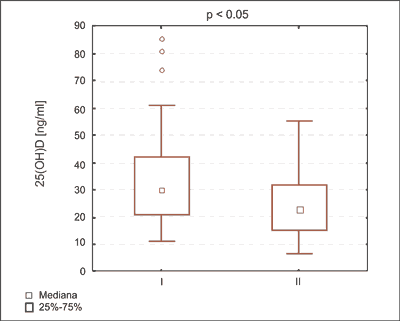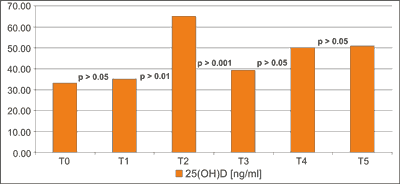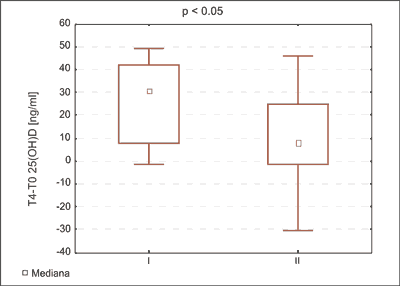© Borgis - Postępy Nauk Medycznych 10/2012, s. 787-793
*Magdalena Kolanko1, Ligia Brzezińska-Wcisło2
Stężenie kalcydiolu u chorych na łuszczycę leczonych fototerapią UVB 311
Calcidiol level in patients with psoriasis treated with NB-UVB therapy
1Dermatology Department, Independent Public Clinical Hospital of Medical University of Silesia, Katowice
Head of Department: prof. Ligia Brzezińska-Wcisło, MD, PhD
2Dermatology Department, Medical University of Silesia, Katowice
Head of Department: prof. Ligia Brzezińska-Wcisło, MD, PhD
Streszczenie
Wstęp. Naświetlania UVB 311nm (NB-UVB) mają wpływ na ekspresję genów substancji ważnych dla przebiegu łuszczycy poprzez zdolność do naskórkowej produkcji witaminy D.
Cel pracy. Celem pracy była ocena ich wpływu na stężenie 25(OH)D w surowicy w zależności od jego wyjściowej wartości oraz BMI, wieku, płci, nawyków żywieniowych i rekreacyjnych.
Materiał i metody. U 36 chorych mierzono stężenie 25(OH)D w surowicy metodą radioimmunologiczną-RIA przed rozpoczęciem fototerapii (T0), po 1., 3. i 6. tygodniu naświetlań (T1-T3) oraz po 1. i 5. tygodniu od jej zakończenia (T4-T5). Kontrolę (28 osób) badano w T0 i T4. Obliczano wartość PASI i BMI, oznaczano fototyp skóry oraz zbierano dane dotyczące stylu życia i danych demograficznych (ankieta).
Wyniki. Stężenie kalcydiolu w T0 było wyższe u pacjentów 33,21 ng/ml niż w kontroli 25,17 ng/ml (p < 0,05). Tendencja do niższych wartości kalcydiolu u osób starszych, kobiet oraz osób z mniejszym PASI nie była istotna (p > 0,05). Stwierdzono istotną różnicę przyrostu stężenia kalcydiolu pomiędzy oznaczeniem T0 a T4 – wyższą dla grupy o stężeniu < 25 ng/ml. W T4 nastąpił wzrost stężenia kalcydiolu u pacjentów – 50,16 ng/ml (p < 0,05), a spadek w kontroli – 21,37 ng/ml. W T5 stężenie kalcydiolu u pacjentów wyniosło 51,18 ng/ml. Codziennie spożycie różnych produktów nabiałowych podawało 11-45% badanych. Spożycie ryb deklarowano jako co najmniej raz w miesiącu.
Wnioski. Początkowe stężenie 25(OH)D wpływa na jego przyrost pod wpływem UVB 311 nm. Otrzymana w trakcie naświetlań dawka promieniowania zamaskowała sezonową zmienność stężenia kalcydiolu. Początkowe stężenie 25(OH)D nie zależy od wartości BMI i PASI, wieku oraz płci. Nawyki żywieniowe i habitualne mają wpływ na stężenie kalcydiolu.
Summary
Introduction. UVB 311nm phototherapy (NB-UVB) appears to influence the psoriasis significant factor’s genes expression by epidermal syntesis of vitamin D.
Aim. The aim of this research was to examine whether NB-UVB was able to induce 25(OH)D synthesis in relationship to its initial level and BMI, age, sex, nutrition and behavioral habits.
Material and methods. Serum 25(OH) D level was measured using RIA-method in 36 patients in T0 before the first dose of radiation, in T1-T3 during the treatment and in T4 and T5 accordingly in 1st and 5th week after the end of phototherapy. The parameters in controls (28 healthy adults) were measured in T0 and T4. Assessment included also: BMI, PASI, skin phototype, questionnaire (sun exposure, nutrition habits).
Results. Calcidiol level in T0 was higher in patients 33.21 nmg/ml vs. 25.17 ng/ml in controls (p < 0.05). The tendency to lower calcidiol levels among older, women and in patients with a lower PASI index value wasn’t significant (p > 0.05). There was a statistically significant difference in the increase of calcidiol level in patients between T0 and T4 – higher in the group of level < 25 ng/ml. There was an increase of calcidiol level in patients in T4 – 50.16 ng/ml (p < 0.05) and a decrease in controls – 21.37 ng/ml. In T5 calcidiol level in patients was 51.18 ng/ml. 11-45% participants reported consumption of different dairy products. The consumption of fish was declared as at least once a month.
Conclusions. The initial level of 25(OH)D has an impact on its growth by NB-UVB. The dose of UVB 311 nm received during the irradiation masked seasonal variability of the calcidiol level. There was no effect of BMI or PASI index values, age or gender on the calcidiol level. Nutrition and behavioral habits have an impact on the calcidiol level.

Introduction
Psoriasis is a genetic inflammatory dermatosis characterized by abnormally exaggerated epidermal cellular turnover and erythematous lesions with silvery scale (plaque psoriasis). This disease constitutes a significant clinical problem due to its high frequency, chronic and recurrent course and no possibility of an ultimate cure (1, 2).
Due to its efficiency, safety and cost-effectiveness, one of the treatment modalities of moderate psoriasis is narrow-band UVB phototherapy (NB-UVB, with a maximum emission at 311 nm), which appears to influence the disease significant factor’s genes expression by epidermal syntesis of vitamin D (3, 4).
Calcitriol (active metabolit of vitamin D) has been shown to affect leucocytes by phosphorylation of their vitamin D receptor (VDR). Further studies showed that 1α, 25(OH)2D directly influences differentiation of Th2, increasing the production of interleukin IL-4, IL-5, IL-10 and TGF-β, and decreasing the synthesis of IL-2 and INF-γ. In this way calcitriol has an antiproliferative effect on keratynocytes (4). It was also confirmed that cacitriol produced in the skin may have an endo- and autocrine effect within keratinocytes themselves, but also a paracrine effect within the neighbouring cells, mainly by regulating their growth, differentiation and apoptosis, which also explains the efficiency of UVB therapy in psoriasis (5, 6).
Vitamin D is obtained in humans in two ways: by photoconversion of 7-dehydrocholesterol (7-DHC; this is its main source: 90-100%) or can be delivered with food (about 10%), especially fish (i.a. salmon, mackerel, sardines, tuna), milk, train-oil and artificial fortified butter and margarine (7, 8).
Calcidiol constitutes a basic form of vitamin D present in the blood with the biological half-time of 19 days (it can be stored in liver and fat tissue for longer time) (7, 9).
Aim
The aim of this research was to examine whether NB-UVB was able to induce serum 25(OH)D synthesis in relation to its initial level and PASI, BMI, age, sex, dietary and behavioral habits of patients with psoriasis treated with phototherapy.
Material and methods
The study was performed in 36 adult patients of the Dermatological Clinic of Medical University of Silesia (SUM) in Katowice (7 women and 29 men), aged 21-72 years (47.92+/-13.31 (mean+/-SD), BMI 19.03-36.42 kg/m2 (27.34+/-3.82), skin phototype II and III (Fitzpatrick) who were qualified to NB-UVB phototherapy due to moderate forms of psoriasis (PASI 8.4-17.4 (12.95+/-2.74)) and 28 healthy volunteers (13 women and 15 men), aged 26-59 years (43.78+/-8.15) and BMI 18.59-32.61 kg/m2 (25.61+/-4.02). Irradiation was conducted in the years 2008-2011, in periods during which the UVB doses present in the atmosphere at this latitude are irrelevant to the cutaneous production of vitamin D (November-March).
Three groups of patients were irradiated (12, 11 and 13 people) in a UV Dermalight-Medisun 2800 PC-AB cabin (Schulze&Böhm GmbH, Germany). The phototherapy started from 0.1 J/cm2 dose and consisted of 20 irradiations (total dose of 22.0 J/cm2) which lasted approximately 7 weeks. Patients assigned to each group started phototherapy on the same day. The control group of healthy volunteers for the patients from group I included 23 people, for group II – 17 people, and for group III – 20 people.
25(OH)D serum concentration was measured by radioimmunoassay method (DiaSource 25OH Vitamin D total-RIA-CT Kit) and was checked 6 times: before the first dose of irradiation (T0), after 1st, 3rd and 6th week of irradiation (T1-T3) and in week 1 and 5 after the end of phototherapy (T4-T5). The parameters of controls were measured 2 times (measurement concurrent with measurements T0 and T4 for patients).
The enrolled persons were subjected to a physical examination and biochemical serum tests assessing liver and kidney functions (creatinine, AlAT, AspAT, billirubine, prothrombin time, INR, fibrinogen in serum) in order to identify possible disturbances influencing vitamin D metabolism. Their dermatological status was assessed using the PASI index according to the Fredriksson’s guidelines, before, during and after the phototherapy. Complete remission was defined as PASI below 3 or its reduction by more than 90% (10, 11). The psoriatic patients were enrolled for UVB phototherapy if PASI was > 7.
The body mass index (BMI), Fitzpatrick’s skin phototype (12) and minimal erythema dose for UVB irradiation (MED, TH-1E lamp (Cosmedico Medizintechnik)) were defined before the treatment started. The data on the disease history in psoriatic patients and the dietary habits, exposition to sun irradiation, demographic information, concomitant diseases, drugs and diet supplements which can influence vitamin D levels in healthy and psoriatic patients were collected in the form of a questionnaire designed by us.
The persons enrolled into the study were informed about its aim and signed written consents for participation. The study obtained the agreement from the SUM Bioethical Commission in Katowice.
The obtained results were subjected to statistical analysis using StatisticaTM v 6.0 PL software. Significant differences were defined as p < 0.05.
Results
The mean levels of 25(OH)D in serum (T0) of the patients were 33.21+/-16.14 ng/ml (mean+/-SD) and significantly higher in comparison to the control groups (p < 0.05) (fig. 1), and remained within the current recommendations (7). When analysing the group according to the month of the treatment’s beginning, higher levels of calcidiol were found at T0 in group 1 (phototherapy started in November (45.34+/-19.32 ng/ml) in comparison to group 2 and 3 (phototherapy started in January; 29.43+/-10.17 and 25.22+/-11.24 ng/ml, respectively – the level defined as hypovitaminosis). The results of mean 25(OH)D concentrations obtained for control group (25.17+/-11.59 ng/ml) and for each patient group (28.25+/11.24, 26.2+/-13,57 and 20.21+/-8.64 ng/ml, respectively) were defined as hypovitaminosis according to the current guidelines. Table 1 shows persons grouped according to the serum 25(OH)D concentration at T0.

Fig. 1. Serum 25(OH)D level (ng/ml) in patient and control groups at T0.
Table 1. Serum 25(OH)D level (ng/ml) in patient and control groups at T0.
| 25(OH)D | Recommended level
(30-80 ng/ml) | Hypo-vitaminosis (20-30 ng/ml) | Deficiency
(10-20 ng/ml) | Deficit
(< 10 ng/ml) | High level
(> 80 ng/ml) |
| Patient groups | 18 (50%) | 10 (27.78%) | 7 (19.44%) | 0 (0%) | 1 (2.78%) |
| Control groups | 16 (29.09%) | 18 (32.73%) | 19 (34.55%) | 2 (3.64%) | 0 (0%) |
After the end of phototherapy (T4), the mean serum levels of 25(OH)D in the combined tested groups increased to 50.16+/-22.29 ng/ml (p = 0.001) and were within the presently valid recommendations. The results obtained for each group were also compliant with the recommended levels and were 64.26+/-19.01, 31.9+/-15.3 and 49.63+/-19.92 ng/ml, respectively. When comparing with T0, a decrease in the percentage of patients with hypovitaminosis and vitamin D deficiency was observed, with an increase in the percentage of patients showing recommended vitamin D levels. The mean calcidiol levels in the control group of 21.37+/-14.5 ng/ml indicated hypovitaminosis and the similar results were obtained for group 1 and 3 (28.23+/15.59 and 25.22+/-13.48 ng/ml, respectively). The group 2 showed a decrease in 25(OH)D concentrations down to 10.45+/-5.9 (vitamin D deficiency). The increase in the percentage of patients with vitamin D deficiency together with a decrease in the percentage of patients with hypovitaminosis and the recommended 25(OH)D levels were observed. The mean calcidiol concentrations in patient groups at T4 were significantly higher in comparison to control groups (p < 0.05).
The significant changes in the level of serum 25(OH)D were observed in periods: T1-T2 (p < 0.001), T2-T3 (p < 0.001), T3-T4 (p < 0.05) and T0-T4 (p = 0.001). The lowest mean calcidiol levels were found at T0, while the highest at T2 (after 3 weeks from the beginning of phototherapy) and were 65.24+/-34.63 ng/ml, figure 2. Quantification performed at 5 weeks after the phototherapy ended (T5) showed that the mean 25(OH)D concentrations in the combined patient groups were at the level similar to that of T4 and were 51.18+/-21.63 ng/ml.

Fig. 2. The changes in the level of serum 25(OH)D (ng/ml) in all periods (T0-T5).
The psoriatic patients were divided into two groups – with the low (< 25 ng/ml, group I) and high (> 25 ng/ml, group II) initial calcidiol levels and compared between the groups for the increases in the parameter between the phototherapy start (T0) and its end (T4). It was concluded that the increase was the highest in the patients with initially low vitamin D levels in comparison to the patients with the higher values (p < 0.05) (fig. 3).

Fig. 3. Increase of 25(OH)D level (ng/ml) between T0 and T4 in the psoriatic patients divided into two groups – with the low (< 25 ng/ml, group I) and high (> 25 ng/ml, group II) initial calcidiol levels.
Powyżej zamieściliśmy fragment artykułu, do którego możesz uzyskać pełny dostęp.
Mam kod dostępu
- Aby uzyskać płatny dostęp do pełnej treści powyższego artykułu albo wszystkich artykułów (w zależności od wybranej opcji), należy wprowadzić kod.
- Wprowadzając kod, akceptują Państwo treść Regulaminu oraz potwierdzają zapoznanie się z nim.
- Aby kupić kod proszę skorzystać z jednej z poniższych opcji.
Opcja #1
24 zł
Wybieram
- dostęp do tego artykułu
- dostęp na 7 dni
uzyskany kod musi być wprowadzony na stronie artykułu, do którego został wykupiony
Opcja #2
59 zł
Wybieram
- dostęp do tego i pozostałych ponad 7000 artykułów
- dostęp na 30 dni
- najpopularniejsza opcja
Opcja #3
119 zł
Wybieram
- dostęp do tego i pozostałych ponad 7000 artykułów
- dostęp na 90 dni
- oszczędzasz 28 zł
Piśmiennictwo
1. Wolska H, Langner A: Obraz kliniczny i przebieg łuszczycy. [W:] Łuszczyca. Wolska H, Langner A, red. Lublin: Czelej 2006; 25-53.
2. Braun-Falco G, Plewig G, Wolff HH, Burgdorf WHC: Dermatologia, Gliński W, Wolska H (eds Polish version) Lublin: Czelej 2002; t. I: 557-578.
3. Menter A, Korman NJ, Elmets CA et al.: Guidelines of care for the management of psoriasis and psoriatic arthritis Section 5. Guidelines of care for the treatment of psoriasis with phototherapy and photochemotherapy. J Am Acad Dermatol 2009; 62: 114-135.
4. Obtułowicz A, Antoszczyk G: Teoretyczne podstawy zastosowania promieniowania wąskopasmowego UVB 311 nm w dermatologii. Post Dermatol Alergol 2010; 5: 426-429.
5. Schuessler M, Astecker N, Herzig G et al.: Skin is an autonomous organ in synthesis, two-step activation and degradation of vitamin D(3): CYP27 in epidermis completes the set of essential vitamin D(3)-hydroxylases. Steroids 2001; 66: 399-408.
6. Lehmann B, Knuschke P, Meurer M: UVB-induced conversion of 7-dehydrocholesterol to 1 alpha,25-dihydroxyvitamin D3 (calcitriol) in the human keratinocyte line HaCaT. Photochem Photobiol 2000; 72: 803-809.
7. Woźniacka A, Bogaczewicz J, Sysa-Jędrzejowska A: Drugie oblicze słońca. Prawdziwy Dylemat. Część 1. Przegl Dermatol 2008; 95: 467-474.
8. Łukaszkiewicz J: Ocena wpływu czynników fizjologicznych i patologicznych na stan zaopatrzenia organizmu w witaminę D. Praca habilitacyjna. Zakład Biochemii i Medycyny Doświadczalnej Centrum Zdrowia Dziecka, Warszawa 1995.
9. Brunton LL, Lazo JS, Parker KL: red. Farmakologia Goodmana & Gilmana, Lublin: Czelej 2007: 1773-1777.
10. Fredriksson T, Pettersson U: Severe psoriasis-oral therapy with a new retinoid. Dermatologica 1978; 157: 238-244.
11. Schmitt L, Wozel G: The Psoriasis Area and Severity Index is the adequate criterion to define severity in chronic plaque-type psoriasis. Dermatology 2005; 210: 194-199.
12. Fitzpatrick TB: The validity and practicability of sunreactive skin types I through VI. Arch Dermatol 1988; 125: 869-871.
13. Poduje S, Sjerobabski-Masnec I, Ozanić-Bulić S: Vitamin D-the true and the false about vitamin D. Coll Antropol 2008; 32: 159-162.
14. Holick MF: Environmental factors that influence the cutaneous production of vitamin D. Am J Clin Nutr 1995; 61: 638S-645S.
15. Grant WB, Garland CF, Holick MF: Comparisons of estimated economic burdens due to insufficient solar ultraviolet irradiance and vitamin D and excess solar UV irradiance for the United States. Photochem Photobiol 2005; 81: 1276-1286.
16. Staberg B, Oxholm A, Klemp P, Hartwell D: Is the effect of phototherapy in psoriasis partly due to an impact on vitamin D metabolism? Acta Derm Venereol 1988; 68: 436-439.
17. Osmancevic A, Landin-Wilhelmsen K, Larkö O et al.: UVB therapy increases 25(OH) vitamin D syntheses in postmenopausal women with psoriasis. Photodermatol Photoimmunol Photomed 2007; 23: 172-178.
18. Ryan C, Moran B, McKenna MJ et al.: The effect of narrowband UV-B treatment for psoriasis on vitamin D status during wintertime in Ireland. Arch Dermatol 2010; 146: 836-842.
19. Lesiak A, Brucka-Stempkowska A, Kubik D et al.: The influence of phototherapy with narrow band UVB on 25-hydroxycholecalciferol serum concentration in psoriasis vulgaris patients. Post Dermatol Alergol 2011; 2: 97-102.
20. Binkley N, Novotny R, Krueger D et al.: Low vitamin D status despite abundant sun exposure. J Clin Endocrinol Metab 2007; 92: 2130-2135.
21. Thieden E, Philipsen PA, Heydenreich J, Wulf HC: Vitamin D level in summer and winter related to measured UVR exposure and behavior. Photochem Photobiol 2009; 85: 1480-1484.
22. Malvy DJ, Guinot C, Preziosi P et al.: Relationship between vitamin D status and skin phototype in general adult population. Photochem Photobiol 2000; 71: 466-469.
23. Cicarma E, Mørk C, Porojnicu AC et al.: Influence of narrowband UVB phototherapy on vitamin D and folate status. Exp Dermatol 2010; 19: e67-72.
24. Bogh MK, Schmedes AV, Philipsen PA et al.: Vitamin D production after UVB exposure depends on baseline vitamin D and total cholesterol but not on skin pigmentation. J Invest Dermatol 2010; 130: 546-553.
25. Kosińska J, Billing-Marczak K, Krotkiewski M: Nowe nieznane funkcje witaminy D. Med Rodz 2008; 46: 35-47.
26. Lu Z, Chen TC, Zhang A et al.: An evaluation of the vitamin D3 content in fish: Is the vitamin D content adequate to satisfy the dietary requirement for vitamin D? J Steroid Biochem Mol Biol 2007; 103: 642-644.
27. Morimoto S, Yoshikawa K, Fukuo K et al.: Inverse relation between severity of psoriasis and serum 1,25-dihydroxy-vitamin D level. J Dermatol Sci 1990; 1: 277-282.
28. Prystowsky JH, Muzio PJ, Sevran S, Clemens TL: Effect of UVB phototherapy and oral calcitriol (1,25-dihydroxyvitamin D3) on vitamin D photosynthesis in patients with psoriasis. J Am Acad Dermatol 1996; 35: 690-695.



